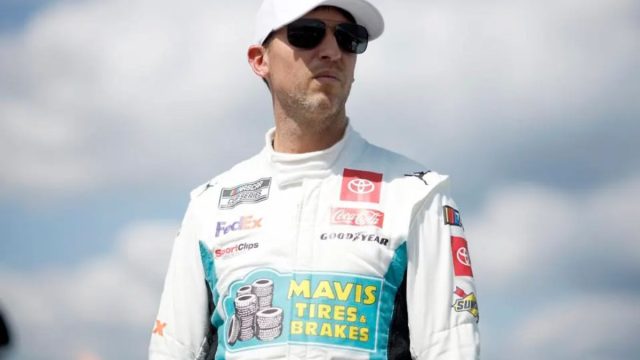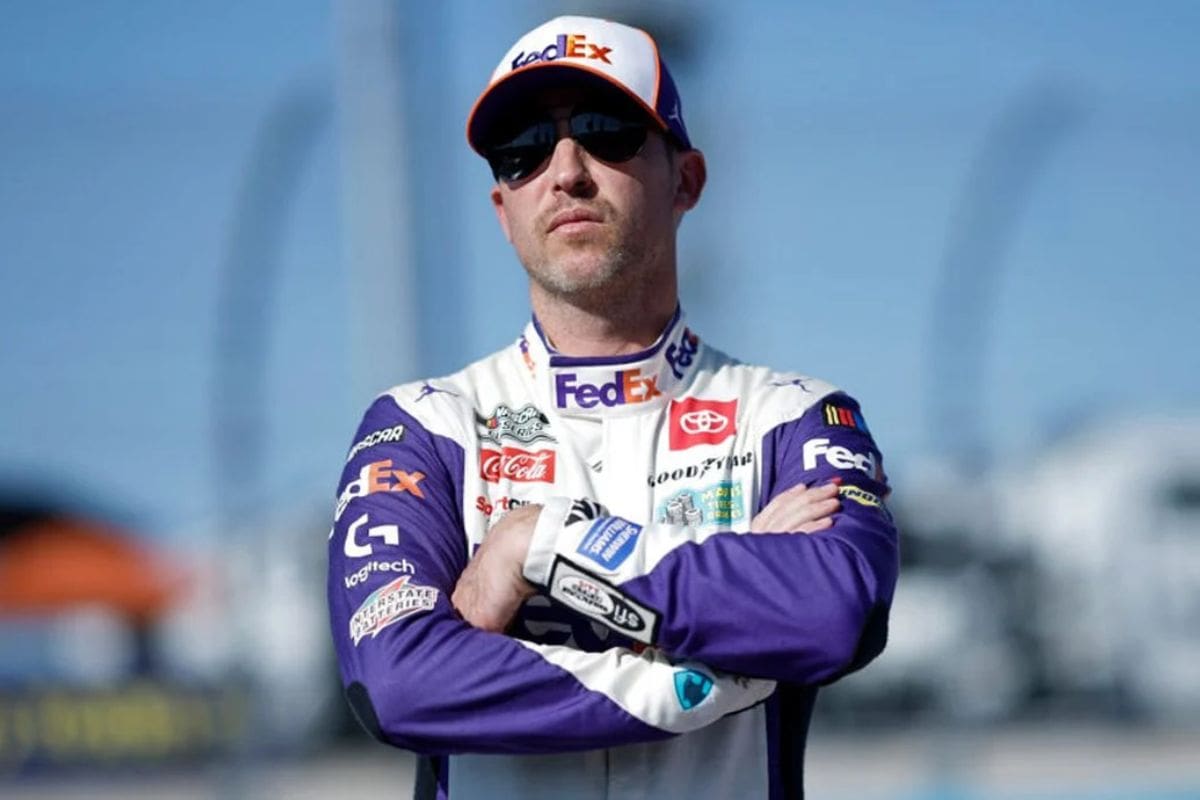Denny Hamlin’s Candid Confession: Denny Hamlin’s unexpected confession about the flawed strategy at Martinsville Speedway not only highlights the inherent unpredictability and complexity of NASCAR racing but also opens a broader conversation about the calculus of risk and decision-making in high-stakes competitions. By acknowledging the improbability of a victory from their position, Hamlin’s transparency reveals a side of sports often obscured by the relentless pursuit of success – the willingness to confront and learn from failure. This revelation invites a deeper exploration into the dynamics of race strategy, the psychological resilience of athletes, and the critical role of honest self-assessment in achieving long-term success in motorsports.
Key Takeaways
- Denny Hamlin admitted a late pit stop strategy at Martinsville Speedway was a miscalculation that cost him positions.
- The strategy was influenced by past successes but failed to achieve the desired outcome in this instance.
- Hamlin’s team aimed to disrupt the race and pressure competitors, acknowledging victory was a long shot.
- This candid confession highlights the risks and uncertainties inherent in NASCAR racing strategies.
- Hamlin views every race decision as a learning opportunity, indicating a continuous quest for improvement.
Denny Hamlin’s Strategy Misstep
Denny Hamlin found himself in a bit of a pickle with a questionable strategy call during the Cook Out 400 at Martinsville Speedway. As the race headed into overtime following a late caution, Hamlin’s crew opted for a cunning move by hitting pit road before the restart. However, the Hendrick Motorsports trio of William Byron, Kyle Larson, and Chase Elliott remained unruffled, holding onto their track position and refusing to take the bait. Hamlin’s gamble ultimately backfired, leaving him to regret the missed opportunity as his rivals surged ahead on the restart.
Amidst the chaos of the closing laps, Denny Hamlin, who had been running strong in fourth place behind the leaders, saw his fortunes take a nosedive. A misstep by his crew led to a plummet down the order, ultimately relegating him to a disappointing 11th-place finish when the checkered flag flew. It was undoubtedly a missed opportunity for Hamlin, who had the potential to contend for a top-5 finish, or perhaps even compete for the victory. With hindsight in play, one can’t help but wonder what might have been if Hamlin had stayed the course and capitalized on his track position to challenge the Hendrick Motorsports front-runners on the restart.
The Failed Gamble
Drawing from the confidence gained from last weekend’s triumph at Richmond Raceway, Denny Hamlin and his team opted for a calculated gamble at Martinsville. Banking on the hope of luring other drivers into making a pit stop, the #11 crew made a strategic decision to pit during overtime just prior to the restart. However, their tactic failed to pay off as none of the lead drivers took the bait, leaving Hamlin to regret the missed opportunity as he watched his rivals maintain their track position ahead of the restart.
The distinct understanding of racecraft and strategy that underpins decisions such as these is often lost in the intricate outcomes of success and failure. However, within this unsuccessful gamble lies intricate decision-making processes that show the delicate balance between risk and reward in NASCAR racing. Hamlin’s team, in opting for a late pit stop, was not merely playing a game of chance. They were attempting to exert pressure on their competitors, to introduce a variable that could disrupt the status quo and potentially catapult them to an advantageous position.
“We were just trying to make a call there to drag some others down with us, but you know the tire wear not being much of anything; it was probably a stretch I think. We weren’t going to win, so the strategy was to pit and try to drag seven or eight cars, but nobody else pitted. We did all we could. We made a call last week, and a great pit crew last week got us the win, and this week it just didn’t work out.” – (Denny)
Denny Hamlin on the gamble of pitting prior to the overtime restart and the ability of William Byron to work his way through traffic on a day when it was tough to pass. pic.twitter.com/BZgb5FtSzJ
— Bob Pockrass (@bobpockrass) April 7, 2024
William Byron’s Tactical Brilliance
Byron’s victory was not just a reflection of his driving prowess but also highlighted the strategic acumen of his team. The early pit stop strategy, although risky, emphasized the importance of timing and how well-timed decisions can greatly influence the outcome of a race. This approach not only kept Byron ahead in the race but also rendered the attempts by competitors like Hamlin to disrupt the race’s flow ineffective.
“I didn’t get to see, but the car is really good and superior, and if you’re a good driver like he is, you’re gonna be able to navigate. I don’t know when they pitted, but it certainly looked like those guys hit the light switch at the end.” – (Denny)
Gabehart’s Explanation
Once William Byron executed the unexpected pit stop ahead of the leading pack, it set the stage for the rest of the field to play catch-up. Adding to Denny Hamlin’s challenges, his crew chief Gabehart disclosed that the JGR driver’s car encountered issues while entering and exiting pit road, further complicating their efforts to close the gap on the lead car. Despite their best efforts to create diversion and chaos during the overtime period, their attempts ultimately fell short, leaving them unable to disrupt Byron’s dominance as he sailed to victory at Martinsville Speedway.
Gabehart’s acknowledgment of the challenges faced by Hamlin on pit road during the pivotal moments of the race speaks to an inherent unpredictability in motorsports. Yet, it’s this unpredictability that Gabehart and his team sought to leverage. By opting for a late pit stop, they aimed not merely to adhere to conventional wisdom but to disrupt the status quo, potentially positioning Hamlin for a more advantageous finish. This decision, while controversial, demonstrates a willingness to embrace risk as an integral component of strategy.
Looking forward, the focus shifts to the upcoming race at Texas Motor Speedway. For Hamlin and his team, the Martinsville episode serves as both a lesson and a catalyst for refinement. The setback, rather than deterring them, appears to be stirring their resolve to rebound with enhanced strategies and performance.
“Yeah, we have two wins, and we’re going to have to restart fourth there. I only told Denny if no one in front of you pits, which means we’re going to restart fourth to go ahead and pit, try to shake it up make something different happen. Fourth or fifth is ultimately no different to us than, tenth or eleventh, given that we have two wins.” – (Chris)
News in Brief
Denny Hamlin’s transparent admission regarding the flawed strategy at Martinsville Speedway highlights the inherent uncertainties and tactical complexities within NASCAR racing. This candid revelation not only sheds light on the challenges teams face in decision-making under pressure but also emphasizes the significance of introspection and learning from unsuccessful endeavors.
William Byron’s tactical acumen, compared with Hamlin’s misstep, further exemplifies the critical role of strategy in the sport. Such openness contributes to a greater understanding of the dynamics at play, fostering a culture of continuous improvement and strategic evolution in NASCAR.
Our Reader’s Queries
Q. What did Denny Hamlin do in NASCAR?
A. In his illustrious career, driver Denny Hamlin has triumphed in an impressive 53 NASCAR Cup Series races. Among his notable victories are the Coca-Cola 600 in 2022, the Southern 500 in 2010, 2017, and 2021, and the prestigious Daytona 500 in 2016, 2019, and 2020. Remarkably, Hamlin’s feat of winning the Daytona 500 in consecutive seasons places him in esteemed company, alongside racing legends Richard Petty, Cale Yarborough, and Sterling Marlin.
ALSO READ: Denny Hamlin’s Secret Weapon? Crew Chief Spills in Shocking 10 Words



